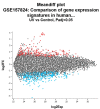Introducing BDNF and SNAI1 as the Crucial Targeted Genes by UV Radiation
- PMID: 37041787
- PMCID: PMC10082910
- DOI: 10.34172/jlms.2022.76
Introducing BDNF and SNAI1 as the Crucial Targeted Genes by UV Radiation
Abstract
Introduction: Due to widespread penetration of UV radiation in human life, the biological effect of UV radiation is studied through many investigations in the field of medicine. There are many assessments about UV radiation which are concerned with protein-protein interaction (PPI) network analysis. In the present study, a network analysis associated with the complementary evaluation of UV radiation on human primary melanocytes is presented. Methods: The gene expression profiles of the irradiated human primary melanocytes and the control cells were extracted from Gene Expression Omnibus (GEO) and were evaluated via PPI network analysis and action map assessment. Results: 69 significant differentially expressed genes (DEGs) were included in the main component of the PPI network. Brain-derived neurotrophic factor (BDNF), SNAI1, and SOCS1 were highlighted as the top dysregulated and hub genes. Results indicate that BDNF and SNAI1 participate in the regulatory unit including the total hubs and top dysregulated genes. Conclusion: Considerable down-regulation of BDNF and up-regulation of SNAI1 as the two critical targeted genes by UV radiation are accompanied by gross alteration in cell functions.
Keywords: Expression change; Gene; Human; Network; UV-radiation.
Copyright © 2022 J Lasers Med Sci.
Conflict of interest statement
The authors declare that they have no conflict of interest.
Figures
Similar articles
-
Assessment of NB-UVB Effects on Skin of Atopic Dermatitis Patients: A Network Analysis.J Lasers Med Sci. 2024 Jul 30;15:e27. doi: 10.34172/jlms.2024.27. eCollection 2024. J Lasers Med Sci. 2024. PMID: 39188927 Free PMC article.
-
Efficacy Evaluation of Treatment of Psoriasis Via Narrow Band-Ultraviolet Radiation.J Lasers Med Sci. 2024 Jul 27;15:e26. doi: 10.34172/jlms.2024.26. eCollection 2024. J Lasers Med Sci. 2024. PMID: 39188934 Free PMC article.
-
Gene Ontology Assessment of Indirect Cold Physical Plasma and UV-Radiation Molecular Mechanism at the Cellular Level.J Lasers Med Sci. 2023 Apr 4;14:e10. doi: 10.34172/jlms.2023.10. eCollection 2023. J Lasers Med Sci. 2023. PMID: 37583495 Free PMC article.
-
Identification of Targeted Central Genes (IGF1 and HMOX1) by Indirect Cold Physical Plasma in Human Melanocytes.J Lasers Med Sci. 2022 Dec 18;13:e70. doi: 10.34172/jlms.2022.70. eCollection 2022. J Lasers Med Sci. 2022. PMID: 37041797 Free PMC article.
-
Introducing Critical Genes in Response to Photodynamic Therapy: A Network Analysis.J Lasers Med Sci. 2023 Aug 10;14:e25. doi: 10.34172/jlms.2023.25. eCollection 2023. J Lasers Med Sci. 2023. PMID: 37744009 Free PMC article.
Cited by
-
Introducing Matrix Metalloproteinases as Crucial Targets for Intra-articular Laser Therapy in Patients with Synovial Fluid of Knee Osteoarthritis.Med J Islam Repub Iran. 2023 Dec 4;37:130. doi: 10.47176/mjiri.37.130. eCollection 2023. Med J Islam Repub Iran. 2023. PMID: 38318399 Free PMC article.
References
-
- Markevich PS, Alekhnovich AV, Kislenko AM, Esipov AA. Use of ultraviolet radiation in modern medicine (Literature review) Bulletin of the Russian Military Medical Academy. 2019;21(3):30–6. doi: 10.17816/brmma20669. - DOI
LinkOut - more resources
Full Text Sources
Research Materials





